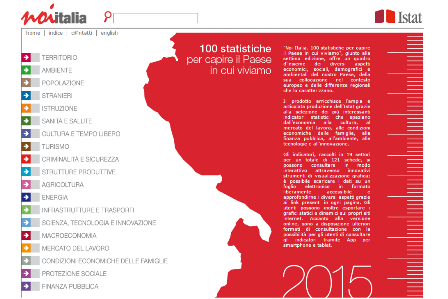
 Umberto Mucci
Umberto Mucci
Italian good news: Noi Italia and We the Italians (part 2)
- WTI Magazine #55 Mar 06, 2015
-

 Umberto Mucci
Umberto Mucci
WTI Magazine #55 2015 March, 6
Author : Umberto Mucci Translation by:
The National Institute for Statistics (Istat) has released its report called "Noi Italia. 100 statistiche per capire il Paese in cui viviamo" (Noi Italia. 100 stats to understand the Country we're living in"). The report provides an overview of the various economic, social, demographic and environmental characteristics of our country, of its position in the European context and the regional differences that characterize it.
The selection involves 121 indicators, collected in 19 areas, ranging from economy to culture, to the labor market, the economic conditions of the families, infrastructure, public finance, the environment, technology and innovation. Many are the bad news, or the ones that see us behind in comparison with the other European countries. But We the Italians always look at the bright side, and so we'll tell you something about the good news in the report, not forgetting that Italy has a lot of homework to do to get better and better. We have divided this analysis in two articles, the first one was published in our previous issue, this is the second one.
Crime and security
In 2013 confirms the decline of voluntary homicides, both consumed and tempted. In European comparison, referring to 2012, with 0.9 murders per 100.000 inhabitants our country ranks below average of UE (1.0). Robberies reported to the authorities in 2013 are almost 44.000 (72.6 per 100 thousand inhabitants), an increase of 2.6% compared to 2012. In Europe, Italy is just above average, preceded among others by the United Kingdom, France and Spain (2012).
In 2014 the 30% of Italian families perceive a high risk of crime in the area where they live, less than the previous years. At the end of 2013 inmates in Italian prisons are 62.536, 4.8% less than in 2012. During 2014 we have a further sharp decrease of inmates (-17.5% in the first ten months). Within the European Union, Italy is below the average of the 28 countries (year 2012).
Production
2012 sees about 64 companies per thousand Italian inhabitants, a value among the highest in Europe: key partners (France, Germany and Spain) have lower values. The rate of entrepreneurship - the ratio between the total number of self-employed workers and businesses – is close to 30% in Italy, the highest among the countries of the EU in 2012. Among the major economies, Germany and France have significantly smaller shares (8.4 and 7.4%). Throughout the country, the propensity for entrepreneurship is higher in the South (37%) than in the Centre-North (28%).
The production structure of the Italian economy is highly diversified across regions. In comparison to the national average, in the South prevail micro enterprises, both in services as industry; in the Northwest we have the most widespread large-scale industry; in the Northeast we have micro and small enterprises in industry and in the center of Italy the big business of the services sector.
The role of women in non-profit Italian institutions is growing. Paid women workers in this sector are 636.000, about twice as many male colleagues, and represent almost 67% of the total. Among the senior management roles, the share of women is just under 36%.
Agriculture
In recent years the interest of European consumers for the quality of food products has increased. In this context, Italy occupies a prominent position and has the highest number of certifications in the UE. At January 1, 2014 the Italian specialty food quality marks are 261.
The number of Italian Agritourism facilities is close to 21 thousand, run by women in more than one third of cases. On a regional basis, about one fifth is concentrated in Tuscany.
Energy
In Italy the per capita consumption of electricity is lower than the European average and of other large countries. The share of gross domestic consumption of electricity from renewable sources continue to increase covered, 33.7% in 2013 (+6.8 percentage points compared to 2012). The comparison with the 28 EU countries sees for Italy higher values than the average, and also higher compared to those of Germany, France and the United Kingdom (year 2012).
Infrastructure and transport
In 2013, the Italian motorway network can count on 6.751 km (4.195 miles) and is just over 9% of the European network. Italy has a railway network of 27.5 km (17 miles) per 100.000 inhabitants, with strong regional differences. The high-speed network covers the 5.6% of the overall network.
The motorization rate is equal to 608 cars per thousand inhabitants, slightly down if compared to 2012. In the European comparison, Italy is by far one of the most used to drive a car, preceded only by Luxembourg. The number of deaths in road accidents continue to decrease. Over the previous year, in 2013 they decreased by 9.8% and involve 56.2 people per million inhabitants.
In 2012 Italy confirms to be the first European country to transport passengers by sea (with over 76.7 million passengers), and climbs up to the fourth place for volume of container traffic after Germany, Spain and the Netherlands.
In 2013, the first countries in the EU for air passenger traffic are the UK, Germany, Spain, France and Italy, all with more than 100 million passengers.
Science, Technology and innovation
In our country, spending on research and development accounts for 1.26% of GDP, an increase over the previous year (2012 data). 93.1% of Italian companies with at least 10 employees are connecting to the Internet via broadband (year 2013), a value above the UE average (90%).
In the years 2010-2012 the share of innovative enterprises passes from 31.5 to 35.5% over the previous three years. Industry remains the most innovative sector, with 45.4% of innovative companies against 29.5% of the services sector and 20.3% of the construction sector. In Europe, Italy is positioned above the average value of the Union, with a higher inclination for innovation than France, the UK and Spain.
In 2012 the number of graduates in technical and scientific disciplines in Italy amounted to 13.2 per thousand residents between 20 and 29 years, steadily increasing since 2000.
Macroeconomics
The share of Italian consumption over our GDP falls to 79.9%, but remains higher than the average of the 28 EU countries (78.5%) and of the leading European countries.
In 2013, labor productivity in Italy is basically in line with the average of the EU countries.
Labor market
In 2013 almost six out of ten people aged 20-64 years are occupied, with a strong gender imbalance against women, and a marked geographical divide between the Centre-North and the South.
Drops to 13.2% the rate of the temporary work: this value is substantially in line with the European average. Instead, grows the share of part-time workers (17.9%).
Economic conditions of the families
In the early months of 2014, 43.5% of people over 14 declares very or fairly satisfied with their economic situation, a share that goes up if compared to last year (40.1%). The level of satisfaction with the economic situation has a strong regional variability, from 66.2% in Bolzano (Trentino Alto Adige) to 30.2% of Sicily.
Social protection
In Italy, spending on social protection exceeds 30% of GDP in 2013; its amount per capita is nearly 8 thousand euro a year. Inside the UE, Italy presents values just above average, both in terms of per capita share and of the GDP.
56.2% of Italian municipalities has activated in 2012 at least one service between kindergarten, crèche or other supplementary childcare services. The disparities between regions in the spread of early childhood services is still wide, with values ranging from 8.8% of Calabria to 100.0% of Friuli Venezia Giulia.
Public finance
In 2013 the net debt is reduced, reaching 2.8% of GDP. Among the EU countries, Italy is in second place, after Germany, for the primary balance as a percentage of GDP (net debt excluding interest expense).